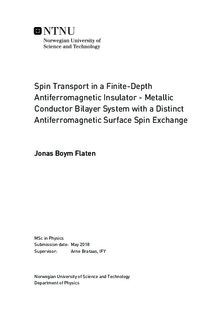| dc.description.abstract | A currently increasing interest in antiferromagnetic insulator spintronics, due to emergent attractive properties such as terahertz operation and spin transport enhancement, encourages theoretical investigation on the topic. In this thesis, a quantum-mechanical operator treatment of the spin transport between an antiferromagnetic insulator layer and a metallic conductor layer is presented. The antiferromagnetic layer has a distinct surface spin exchange, and both layers are of finite depth, as opposed to earlier work on similar systems.
In chapter 2, a simple cubic antiferromagnetic Heisenberg Hamiltonian with an easy-axis term is used to model the antiferromagnetic layer. The magnonic energy eigenstates are then calculated by bosonic diagonalisation of this Hamiltonian through a Holstein-Primakoff transformation, a Fourier transformation and an ansatz-based Bogoliubov transformation.
In chapter 3, a simple cubic tight-binding Hamiltonian with an antiferromagnetic interaction term is used to model the metallic layer. The electronic energy eigenstates are then calculated by fermionic diagonalisation of this Hamiltonian through a Fourier transformation and a canonical unitary transformation.
The antiferromagnetic and metallic diagonalisations are both shown to result in non-trivial trigonometric-hyperbolic systems of equations, which are solved numerically and compared to the results of direct numerical diagonalisations in their respective chapters. All numerical calculations are implemented and executed with a script provided in the appendix.
Finally in chapter 4, general expressions for the spin transport rates across the anti-ferromagnetic insulator-metallic conductor junction are derived by modelling the spin pumping/spin-transfer torque mechanism with an antiferromagnetic Heisenberg Hamiltonian and treating it as a small perturbation to invoke Fermi's golden rule.
The equations and expressions determining the magnons, electrons and spin transport of the bilayer system are concisely summed up in sections 2.16, 3.13 and 4.5. They provide the foundation for a variety of future work on spin transport phenomena, including the possibility of modelling trilayer systems with antiferromagnetic insulator interlayers to investigate theoretically the documented enhanced spin transport. | |

